Project Leadership: Analyzing Styles for J&J Furnishings Case Study
VerifiedAdded on 2022/09/16
|9
|2545
|17
Report
AI Summary
This report analyzes leadership styles and their application in project management, using the J&J Furnishings case study as a basis. It explores the selection of a specific leadership style focusing on efficiency and results, incorporating employee feedback for improved productivity and emphasizing the importance of employee input and authority. The report details tools and techniques like observation, performance appraisals, and interpersonal skills to influence the project team, and discusses the use of reward power to motivate team members, highlighting both its benefits and potential drawbacks. Furthermore, it outlines proactive steps a project manager can take to mitigate challenges within the team and work environment, emphasizing the importance of clear objectives, technological proficiency, effective customer support, and maintaining a positive work environment to ensure project success and uphold the company's values. The report also includes a discussion on conflict management techniques, such as withdrawal, accommodation, compromise, force, and collaboration, and their application in resolving team conflicts.
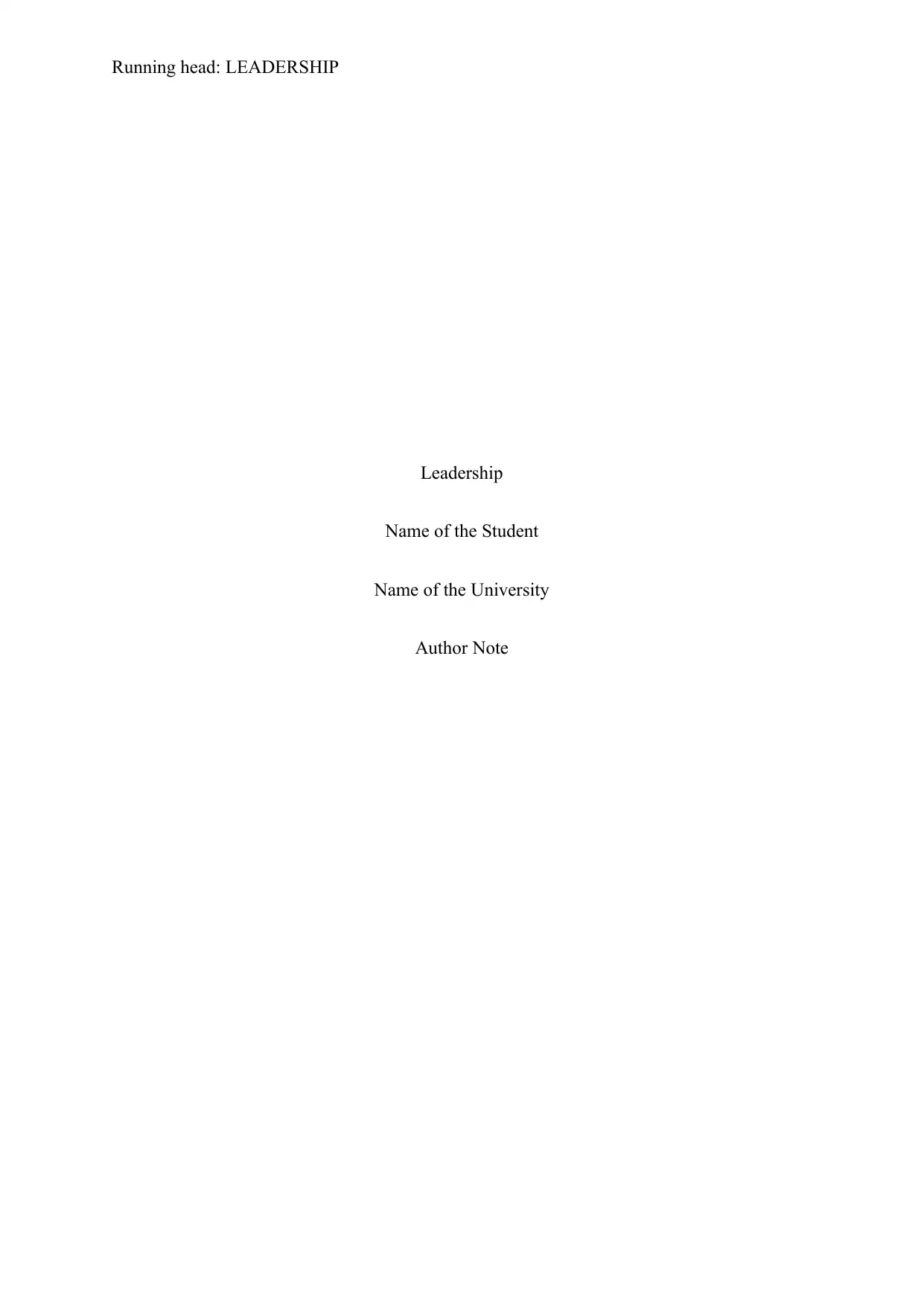
Running head: LEADERSHIP
Leadership
Name of the Student
Name of the University
Author Note
Leadership
Name of the Student
Name of the University
Author Note
Paraphrase This Document
Need a fresh take? Get an instant paraphrase of this document with our AI Paraphraser
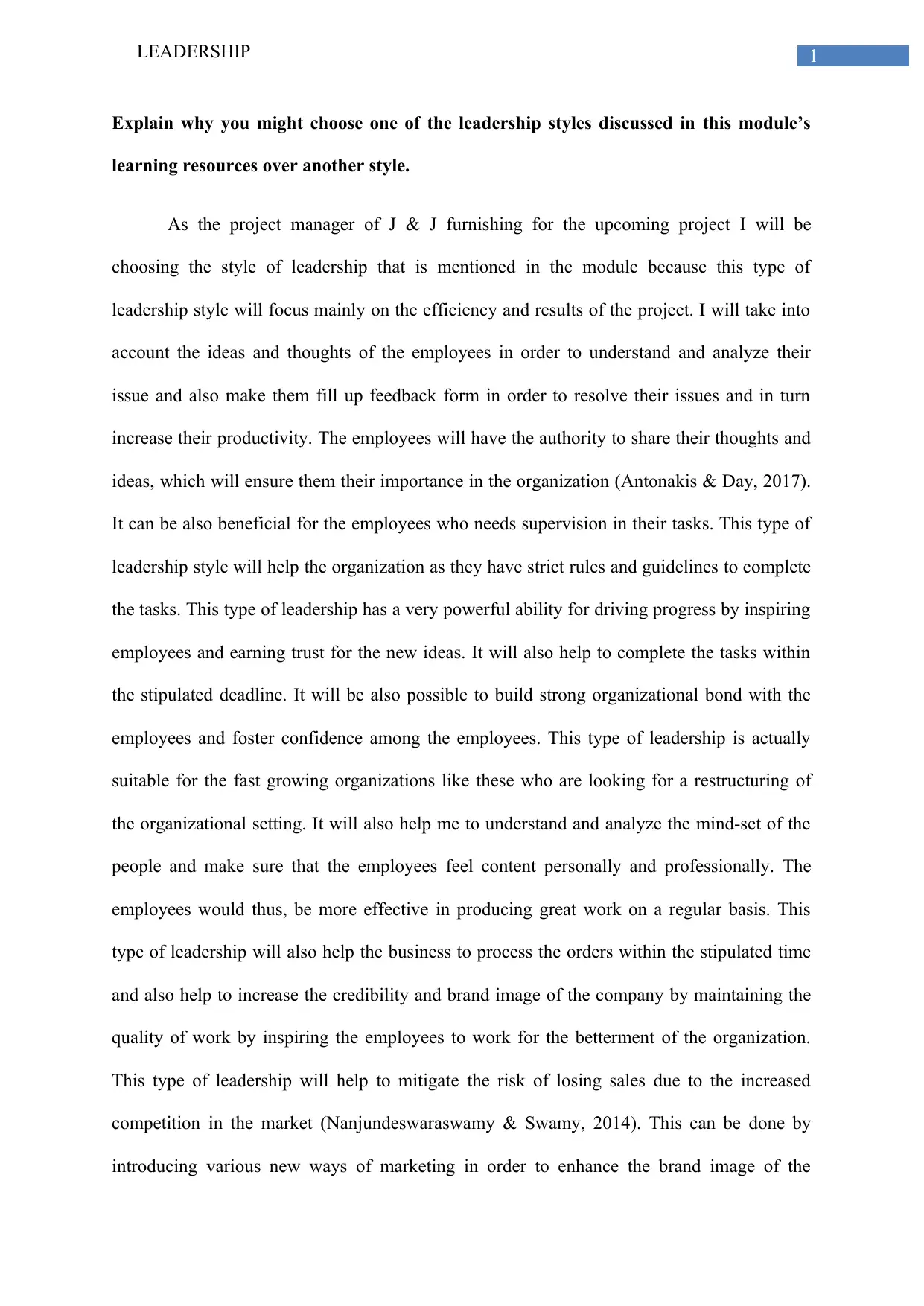
1LEADERSHIP
Explain why you might choose one of the leadership styles discussed in this module’s
learning resources over another style.
As the project manager of J & J furnishing for the upcoming project I will be
choosing the style of leadership that is mentioned in the module because this type of
leadership style will focus mainly on the efficiency and results of the project. I will take into
account the ideas and thoughts of the employees in order to understand and analyze their
issue and also make them fill up feedback form in order to resolve their issues and in turn
increase their productivity. The employees will have the authority to share their thoughts and
ideas, which will ensure them their importance in the organization (Antonakis & Day, 2017).
It can be also beneficial for the employees who needs supervision in their tasks. This type of
leadership style will help the organization as they have strict rules and guidelines to complete
the tasks. This type of leadership has a very powerful ability for driving progress by inspiring
employees and earning trust for the new ideas. It will also help to complete the tasks within
the stipulated deadline. It will be also possible to build strong organizational bond with the
employees and foster confidence among the employees. This type of leadership is actually
suitable for the fast growing organizations like these who are looking for a restructuring of
the organizational setting. It will also help me to understand and analyze the mind-set of the
people and make sure that the employees feel content personally and professionally. The
employees would thus, be more effective in producing great work on a regular basis. This
type of leadership will also help the business to process the orders within the stipulated time
and also help to increase the credibility and brand image of the company by maintaining the
quality of work by inspiring the employees to work for the betterment of the organization.
This type of leadership will help to mitigate the risk of losing sales due to the increased
competition in the market (Nanjundeswaraswamy & Swamy, 2014). This can be done by
introducing various new ways of marketing in order to enhance the brand image of the
Explain why you might choose one of the leadership styles discussed in this module’s
learning resources over another style.
As the project manager of J & J furnishing for the upcoming project I will be
choosing the style of leadership that is mentioned in the module because this type of
leadership style will focus mainly on the efficiency and results of the project. I will take into
account the ideas and thoughts of the employees in order to understand and analyze their
issue and also make them fill up feedback form in order to resolve their issues and in turn
increase their productivity. The employees will have the authority to share their thoughts and
ideas, which will ensure them their importance in the organization (Antonakis & Day, 2017).
It can be also beneficial for the employees who needs supervision in their tasks. This type of
leadership style will help the organization as they have strict rules and guidelines to complete
the tasks. This type of leadership has a very powerful ability for driving progress by inspiring
employees and earning trust for the new ideas. It will also help to complete the tasks within
the stipulated deadline. It will be also possible to build strong organizational bond with the
employees and foster confidence among the employees. This type of leadership is actually
suitable for the fast growing organizations like these who are looking for a restructuring of
the organizational setting. It will also help me to understand and analyze the mind-set of the
people and make sure that the employees feel content personally and professionally. The
employees would thus, be more effective in producing great work on a regular basis. This
type of leadership will also help the business to process the orders within the stipulated time
and also help to increase the credibility and brand image of the company by maintaining the
quality of work by inspiring the employees to work for the betterment of the organization.
This type of leadership will help to mitigate the risk of losing sales due to the increased
competition in the market (Nanjundeswaraswamy & Swamy, 2014). This can be done by
introducing various new ways of marketing in order to enhance the brand image of the
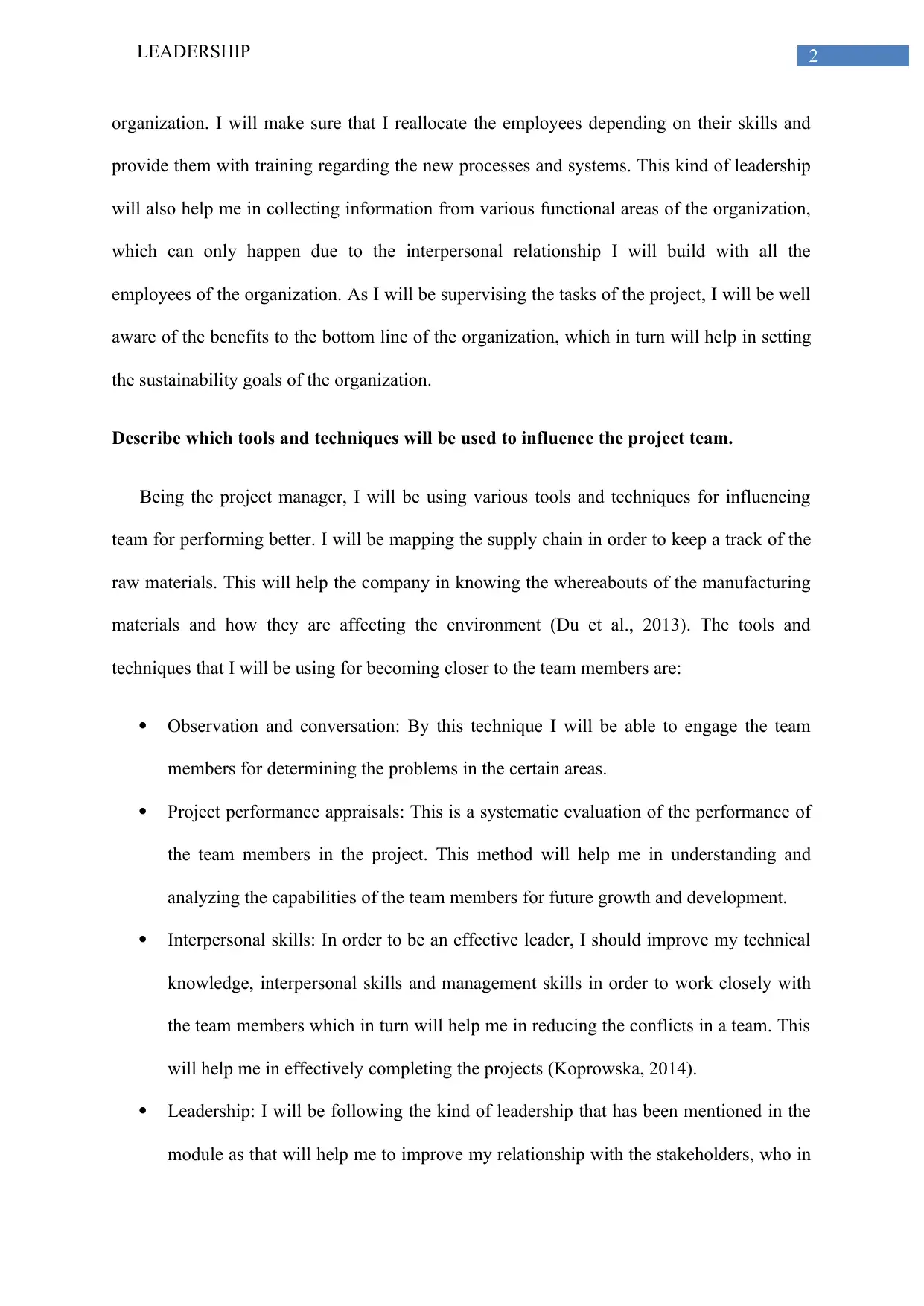
2LEADERSHIP
organization. I will make sure that I reallocate the employees depending on their skills and
provide them with training regarding the new processes and systems. This kind of leadership
will also help me in collecting information from various functional areas of the organization,
which can only happen due to the interpersonal relationship I will build with all the
employees of the organization. As I will be supervising the tasks of the project, I will be well
aware of the benefits to the bottom line of the organization, which in turn will help in setting
the sustainability goals of the organization.
Describe which tools and techniques will be used to influence the project team.
Being the project manager, I will be using various tools and techniques for influencing
team for performing better. I will be mapping the supply chain in order to keep a track of the
raw materials. This will help the company in knowing the whereabouts of the manufacturing
materials and how they are affecting the environment (Du et al., 2013). The tools and
techniques that I will be using for becoming closer to the team members are:
Observation and conversation: By this technique I will be able to engage the team
members for determining the problems in the certain areas.
Project performance appraisals: This is a systematic evaluation of the performance of
the team members in the project. This method will help me in understanding and
analyzing the capabilities of the team members for future growth and development.
Interpersonal skills: In order to be an effective leader, I should improve my technical
knowledge, interpersonal skills and management skills in order to work closely with
the team members which in turn will help me in reducing the conflicts in a team. This
will help me in effectively completing the projects (Koprowska, 2014).
Leadership: I will be following the kind of leadership that has been mentioned in the
module as that will help me to improve my relationship with the stakeholders, who in
organization. I will make sure that I reallocate the employees depending on their skills and
provide them with training regarding the new processes and systems. This kind of leadership
will also help me in collecting information from various functional areas of the organization,
which can only happen due to the interpersonal relationship I will build with all the
employees of the organization. As I will be supervising the tasks of the project, I will be well
aware of the benefits to the bottom line of the organization, which in turn will help in setting
the sustainability goals of the organization.
Describe which tools and techniques will be used to influence the project team.
Being the project manager, I will be using various tools and techniques for influencing
team for performing better. I will be mapping the supply chain in order to keep a track of the
raw materials. This will help the company in knowing the whereabouts of the manufacturing
materials and how they are affecting the environment (Du et al., 2013). The tools and
techniques that I will be using for becoming closer to the team members are:
Observation and conversation: By this technique I will be able to engage the team
members for determining the problems in the certain areas.
Project performance appraisals: This is a systematic evaluation of the performance of
the team members in the project. This method will help me in understanding and
analyzing the capabilities of the team members for future growth and development.
Interpersonal skills: In order to be an effective leader, I should improve my technical
knowledge, interpersonal skills and management skills in order to work closely with
the team members which in turn will help me in reducing the conflicts in a team. This
will help me in effectively completing the projects (Koprowska, 2014).
Leadership: I will be following the kind of leadership that has been mentioned in the
module as that will help me to improve my relationship with the stakeholders, who in
⊘ This is a preview!⊘
Do you want full access?
Subscribe today to unlock all pages.

Trusted by 1+ million students worldwide
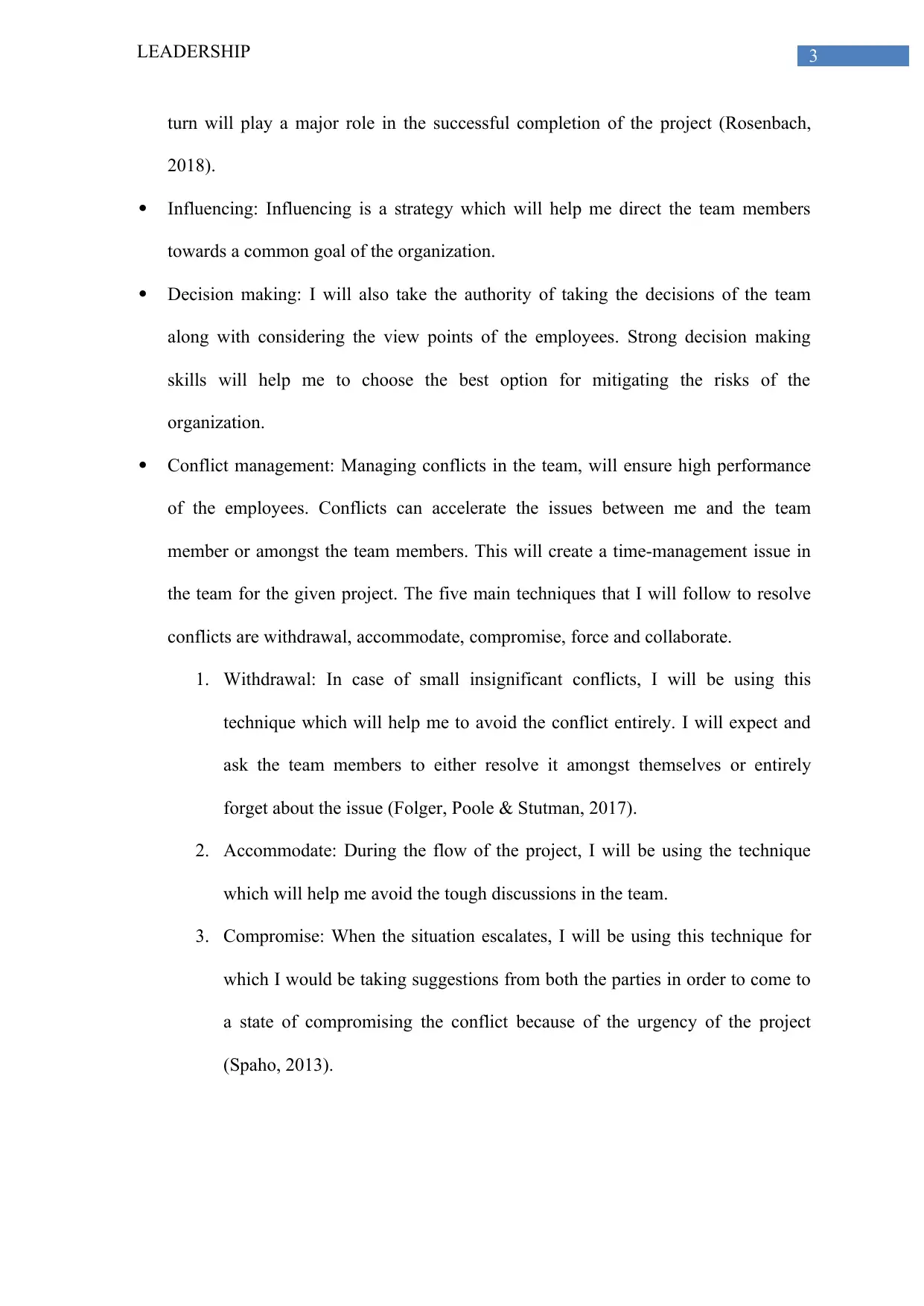
3LEADERSHIP
turn will play a major role in the successful completion of the project (Rosenbach,
2018).
Influencing: Influencing is a strategy which will help me direct the team members
towards a common goal of the organization.
Decision making: I will also take the authority of taking the decisions of the team
along with considering the view points of the employees. Strong decision making
skills will help me to choose the best option for mitigating the risks of the
organization.
Conflict management: Managing conflicts in the team, will ensure high performance
of the employees. Conflicts can accelerate the issues between me and the team
member or amongst the team members. This will create a time-management issue in
the team for the given project. The five main techniques that I will follow to resolve
conflicts are withdrawal, accommodate, compromise, force and collaborate.
1. Withdrawal: In case of small insignificant conflicts, I will be using this
technique which will help me to avoid the conflict entirely. I will expect and
ask the team members to either resolve it amongst themselves or entirely
forget about the issue (Folger, Poole & Stutman, 2017).
2. Accommodate: During the flow of the project, I will be using the technique
which will help me avoid the tough discussions in the team.
3. Compromise: When the situation escalates, I will be using this technique for
which I would be taking suggestions from both the parties in order to come to
a state of compromising the conflict because of the urgency of the project
(Spaho, 2013).
turn will play a major role in the successful completion of the project (Rosenbach,
2018).
Influencing: Influencing is a strategy which will help me direct the team members
towards a common goal of the organization.
Decision making: I will also take the authority of taking the decisions of the team
along with considering the view points of the employees. Strong decision making
skills will help me to choose the best option for mitigating the risks of the
organization.
Conflict management: Managing conflicts in the team, will ensure high performance
of the employees. Conflicts can accelerate the issues between me and the team
member or amongst the team members. This will create a time-management issue in
the team for the given project. The five main techniques that I will follow to resolve
conflicts are withdrawal, accommodate, compromise, force and collaborate.
1. Withdrawal: In case of small insignificant conflicts, I will be using this
technique which will help me to avoid the conflict entirely. I will expect and
ask the team members to either resolve it amongst themselves or entirely
forget about the issue (Folger, Poole & Stutman, 2017).
2. Accommodate: During the flow of the project, I will be using the technique
which will help me avoid the tough discussions in the team.
3. Compromise: When the situation escalates, I will be using this technique for
which I would be taking suggestions from both the parties in order to come to
a state of compromising the conflict because of the urgency of the project
(Spaho, 2013).
Paraphrase This Document
Need a fresh take? Get an instant paraphrase of this document with our AI Paraphraser
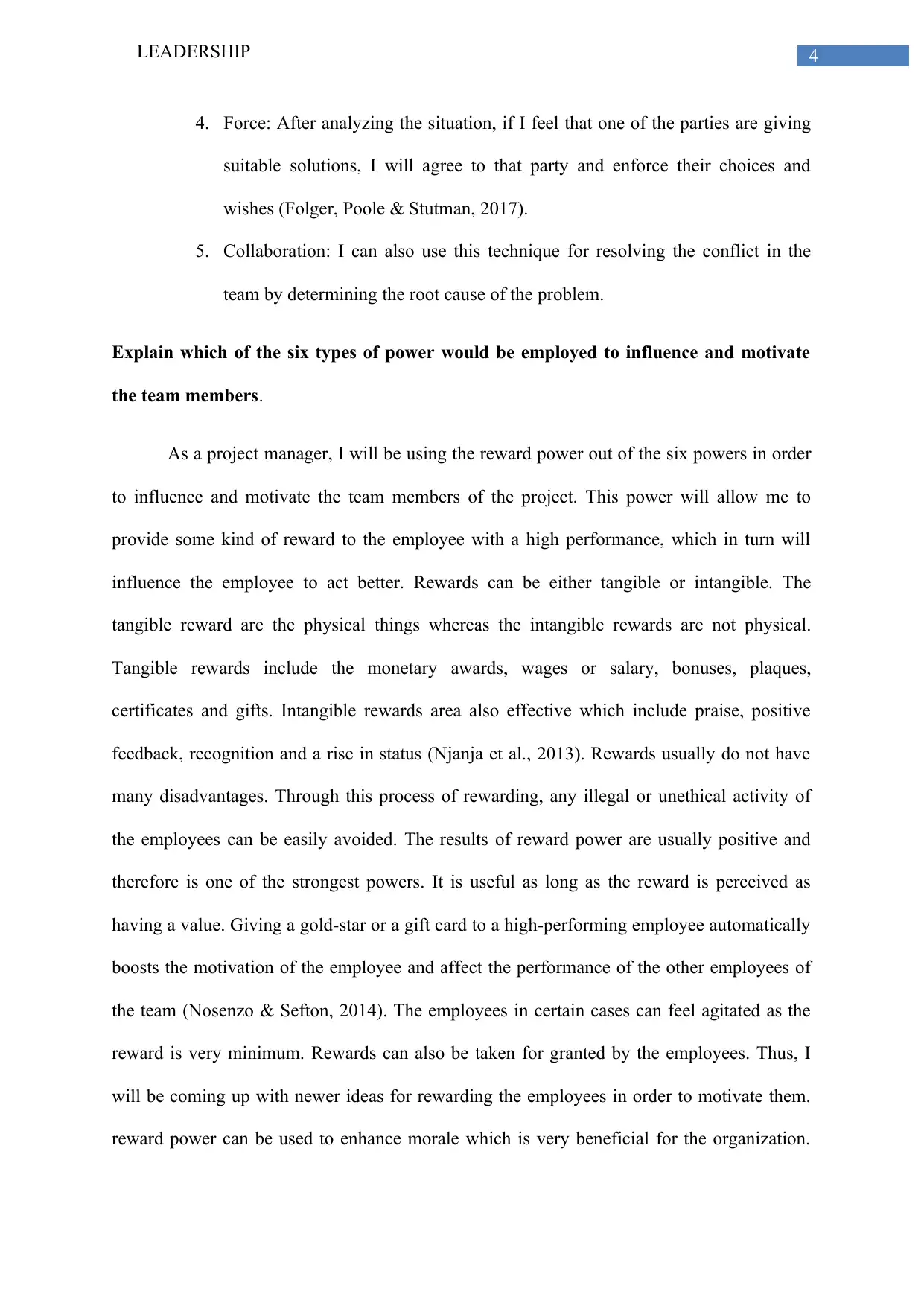
4LEADERSHIP
4. Force: After analyzing the situation, if I feel that one of the parties are giving
suitable solutions, I will agree to that party and enforce their choices and
wishes (Folger, Poole & Stutman, 2017).
5. Collaboration: I can also use this technique for resolving the conflict in the
team by determining the root cause of the problem.
Explain which of the six types of power would be employed to influence and motivate
the team members.
As a project manager, I will be using the reward power out of the six powers in order
to influence and motivate the team members of the project. This power will allow me to
provide some kind of reward to the employee with a high performance, which in turn will
influence the employee to act better. Rewards can be either tangible or intangible. The
tangible reward are the physical things whereas the intangible rewards are not physical.
Tangible rewards include the monetary awards, wages or salary, bonuses, plaques,
certificates and gifts. Intangible rewards area also effective which include praise, positive
feedback, recognition and a rise in status (Njanja et al., 2013). Rewards usually do not have
many disadvantages. Through this process of rewarding, any illegal or unethical activity of
the employees can be easily avoided. The results of reward power are usually positive and
therefore is one of the strongest powers. It is useful as long as the reward is perceived as
having a value. Giving a gold-star or a gift card to a high-performing employee automatically
boosts the motivation of the employee and affect the performance of the other employees of
the team (Nosenzo & Sefton, 2014). The employees in certain cases can feel agitated as the
reward is very minimum. Rewards can also be taken for granted by the employees. Thus, I
will be coming up with newer ideas for rewarding the employees in order to motivate them.
reward power can be used to enhance morale which is very beneficial for the organization.
4. Force: After analyzing the situation, if I feel that one of the parties are giving
suitable solutions, I will agree to that party and enforce their choices and
wishes (Folger, Poole & Stutman, 2017).
5. Collaboration: I can also use this technique for resolving the conflict in the
team by determining the root cause of the problem.
Explain which of the six types of power would be employed to influence and motivate
the team members.
As a project manager, I will be using the reward power out of the six powers in order
to influence and motivate the team members of the project. This power will allow me to
provide some kind of reward to the employee with a high performance, which in turn will
influence the employee to act better. Rewards can be either tangible or intangible. The
tangible reward are the physical things whereas the intangible rewards are not physical.
Tangible rewards include the monetary awards, wages or salary, bonuses, plaques,
certificates and gifts. Intangible rewards area also effective which include praise, positive
feedback, recognition and a rise in status (Njanja et al., 2013). Rewards usually do not have
many disadvantages. Through this process of rewarding, any illegal or unethical activity of
the employees can be easily avoided. The results of reward power are usually positive and
therefore is one of the strongest powers. It is useful as long as the reward is perceived as
having a value. Giving a gold-star or a gift card to a high-performing employee automatically
boosts the motivation of the employee and affect the performance of the other employees of
the team (Nosenzo & Sefton, 2014). The employees in certain cases can feel agitated as the
reward is very minimum. Rewards can also be taken for granted by the employees. Thus, I
will be coming up with newer ideas for rewarding the employees in order to motivate them.
reward power can be used to enhance morale which is very beneficial for the organization.
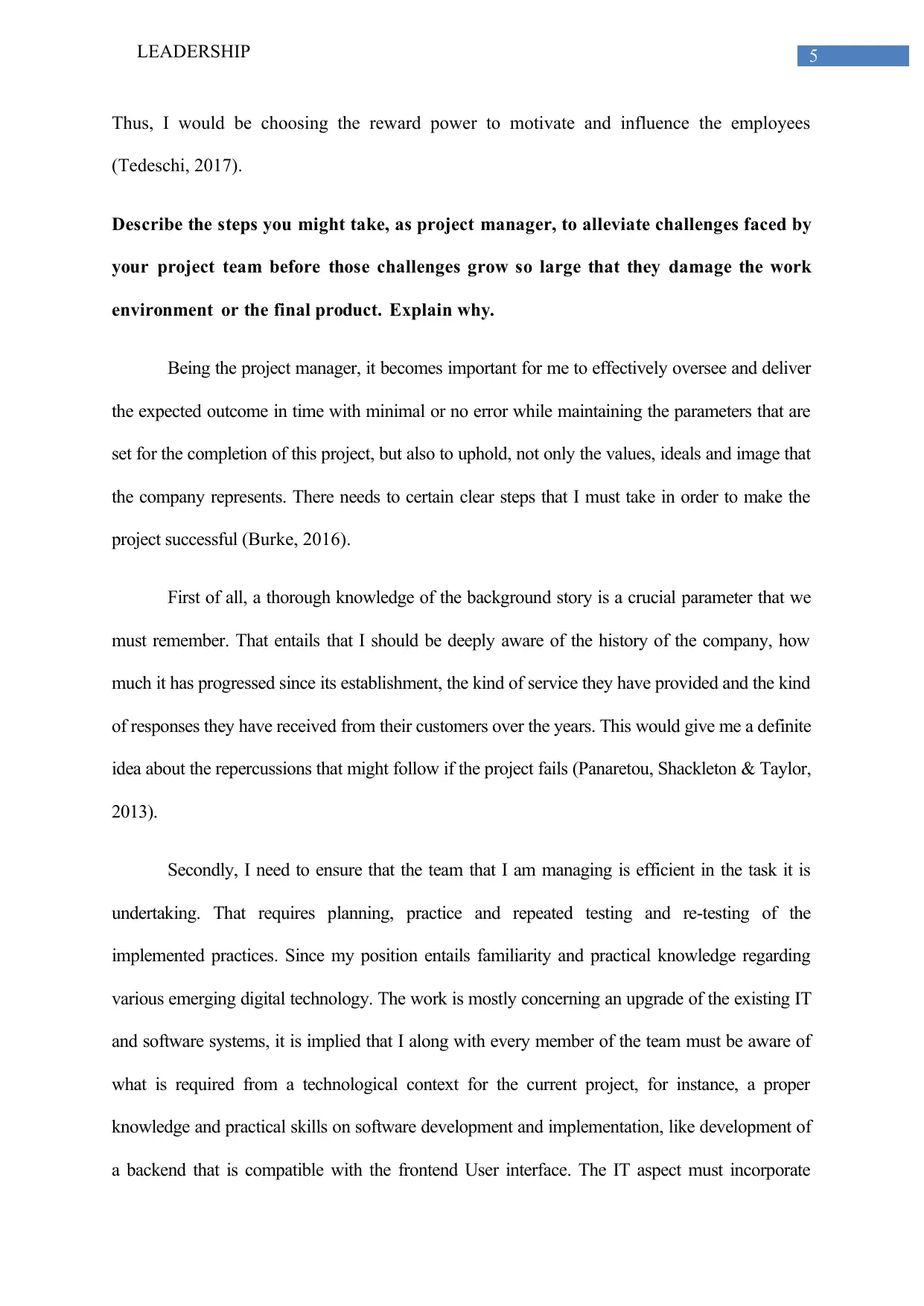
5LEADERSHIP
Thus, I would be choosing the reward power to motivate and influence the employees
(Tedeschi, 2017).
Describe the steps you might take, as project manager, to alleviate challenges faced by
your project team before those challenges grow so large that they damage the work
environment or the final product. Explain why.
Being the project manager, it becomes important for me to effectively oversee and deliver
the expected outcome in time with minimal or no error while maintaining the parameters that are
set for the completion of this project, but also to uphold, not only the values, ideals and image that
the company represents. There needs to certain clear steps that I must take in order to make the
project successful (Burke, 2016).
First of all, a thorough knowledge of the background story is a crucial parameter that we
must remember. That entails that I should be deeply aware of the history of the company, how
much it has progressed since its establishment, the kind of service they have provided and the kind
of responses they have received from their customers over the years. This would give me a definite
idea about the repercussions that might follow if the project fails (Panaretou, Shackleton & Taylor,
2013).
Secondly, I need to ensure that the team that I am managing is efficient in the task it is
undertaking. That requires planning, practice and repeated testing and re-testing of the
implemented practices. Since my position entails familiarity and practical knowledge regarding
various emerging digital technology. The work is mostly concerning an upgrade of the existing IT
and software systems, it is implied that I along with every member of the team must be aware of
what is required from a technological context for the current project, for instance, a proper
knowledge and practical skills on software development and implementation, like development of
a backend that is compatible with the frontend User interface. The IT aspect must incorporate
Thus, I would be choosing the reward power to motivate and influence the employees
(Tedeschi, 2017).
Describe the steps you might take, as project manager, to alleviate challenges faced by
your project team before those challenges grow so large that they damage the work
environment or the final product. Explain why.
Being the project manager, it becomes important for me to effectively oversee and deliver
the expected outcome in time with minimal or no error while maintaining the parameters that are
set for the completion of this project, but also to uphold, not only the values, ideals and image that
the company represents. There needs to certain clear steps that I must take in order to make the
project successful (Burke, 2016).
First of all, a thorough knowledge of the background story is a crucial parameter that we
must remember. That entails that I should be deeply aware of the history of the company, how
much it has progressed since its establishment, the kind of service they have provided and the kind
of responses they have received from their customers over the years. This would give me a definite
idea about the repercussions that might follow if the project fails (Panaretou, Shackleton & Taylor,
2013).
Secondly, I need to ensure that the team that I am managing is efficient in the task it is
undertaking. That requires planning, practice and repeated testing and re-testing of the
implemented practices. Since my position entails familiarity and practical knowledge regarding
various emerging digital technology. The work is mostly concerning an upgrade of the existing IT
and software systems, it is implied that I along with every member of the team must be aware of
what is required from a technological context for the current project, for instance, a proper
knowledge and practical skills on software development and implementation, like development of
a backend that is compatible with the frontend User interface. The IT aspect must incorporate
⊘ This is a preview!⊘
Do you want full access?
Subscribe today to unlock all pages.

Trusted by 1+ million students worldwide
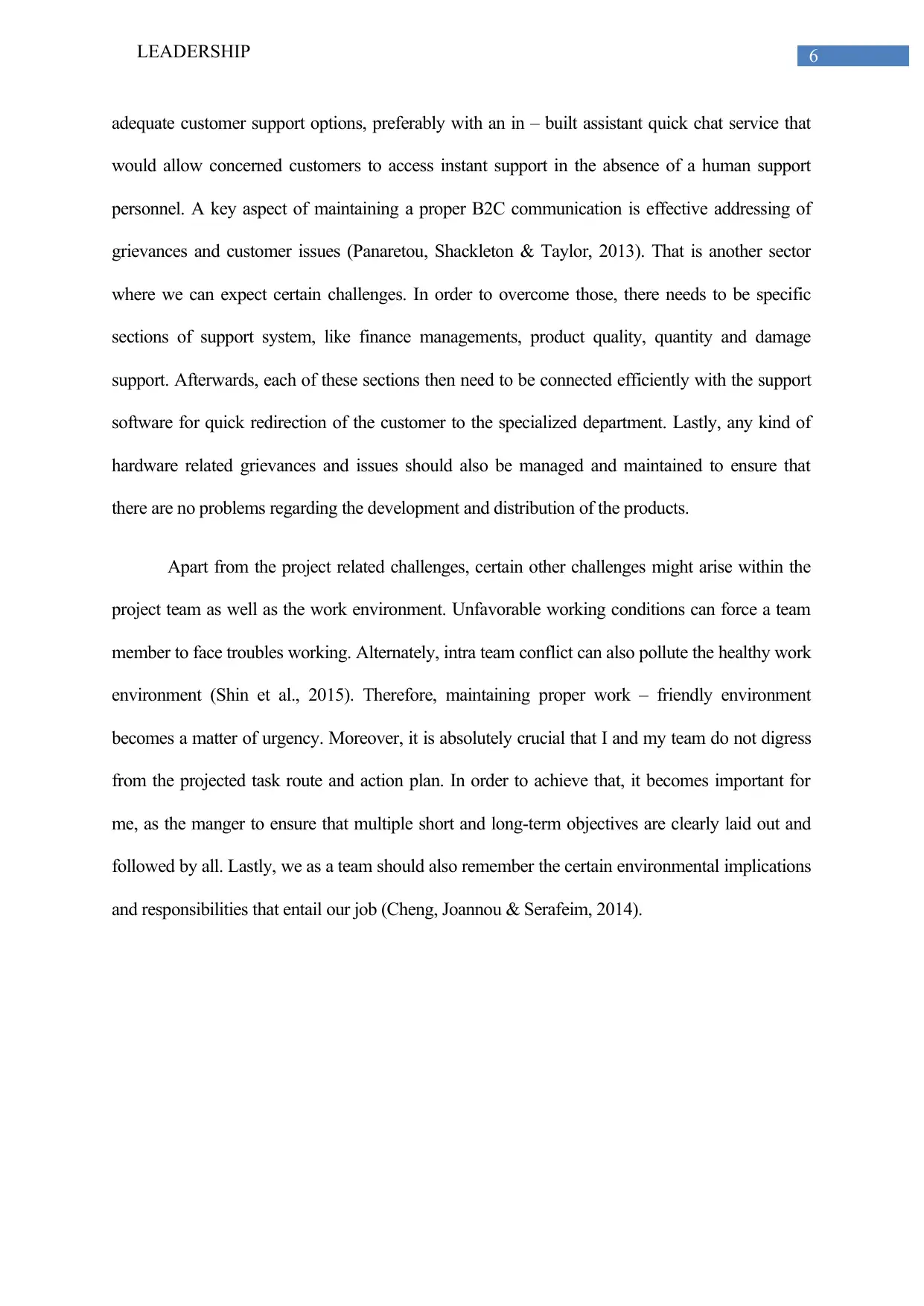
6LEADERSHIP
adequate customer support options, preferably with an in – built assistant quick chat service that
would allow concerned customers to access instant support in the absence of a human support
personnel. A key aspect of maintaining a proper B2C communication is effective addressing of
grievances and customer issues (Panaretou, Shackleton & Taylor, 2013). That is another sector
where we can expect certain challenges. In order to overcome those, there needs to be specific
sections of support system, like finance managements, product quality, quantity and damage
support. Afterwards, each of these sections then need to be connected efficiently with the support
software for quick redirection of the customer to the specialized department. Lastly, any kind of
hardware related grievances and issues should also be managed and maintained to ensure that
there are no problems regarding the development and distribution of the products.
Apart from the project related challenges, certain other challenges might arise within the
project team as well as the work environment. Unfavorable working conditions can force a team
member to face troubles working. Alternately, intra team conflict can also pollute the healthy work
environment (Shin et al., 2015). Therefore, maintaining proper work – friendly environment
becomes a matter of urgency. Moreover, it is absolutely crucial that I and my team do not digress
from the projected task route and action plan. In order to achieve that, it becomes important for
me, as the manger to ensure that multiple short and long-term objectives are clearly laid out and
followed by all. Lastly, we as a team should also remember the certain environmental implications
and responsibilities that entail our job (Cheng, Joannou & Serafeim, 2014).
adequate customer support options, preferably with an in – built assistant quick chat service that
would allow concerned customers to access instant support in the absence of a human support
personnel. A key aspect of maintaining a proper B2C communication is effective addressing of
grievances and customer issues (Panaretou, Shackleton & Taylor, 2013). That is another sector
where we can expect certain challenges. In order to overcome those, there needs to be specific
sections of support system, like finance managements, product quality, quantity and damage
support. Afterwards, each of these sections then need to be connected efficiently with the support
software for quick redirection of the customer to the specialized department. Lastly, any kind of
hardware related grievances and issues should also be managed and maintained to ensure that
there are no problems regarding the development and distribution of the products.
Apart from the project related challenges, certain other challenges might arise within the
project team as well as the work environment. Unfavorable working conditions can force a team
member to face troubles working. Alternately, intra team conflict can also pollute the healthy work
environment (Shin et al., 2015). Therefore, maintaining proper work – friendly environment
becomes a matter of urgency. Moreover, it is absolutely crucial that I and my team do not digress
from the projected task route and action plan. In order to achieve that, it becomes important for
me, as the manger to ensure that multiple short and long-term objectives are clearly laid out and
followed by all. Lastly, we as a team should also remember the certain environmental implications
and responsibilities that entail our job (Cheng, Joannou & Serafeim, 2014).
Paraphrase This Document
Need a fresh take? Get an instant paraphrase of this document with our AI Paraphraser
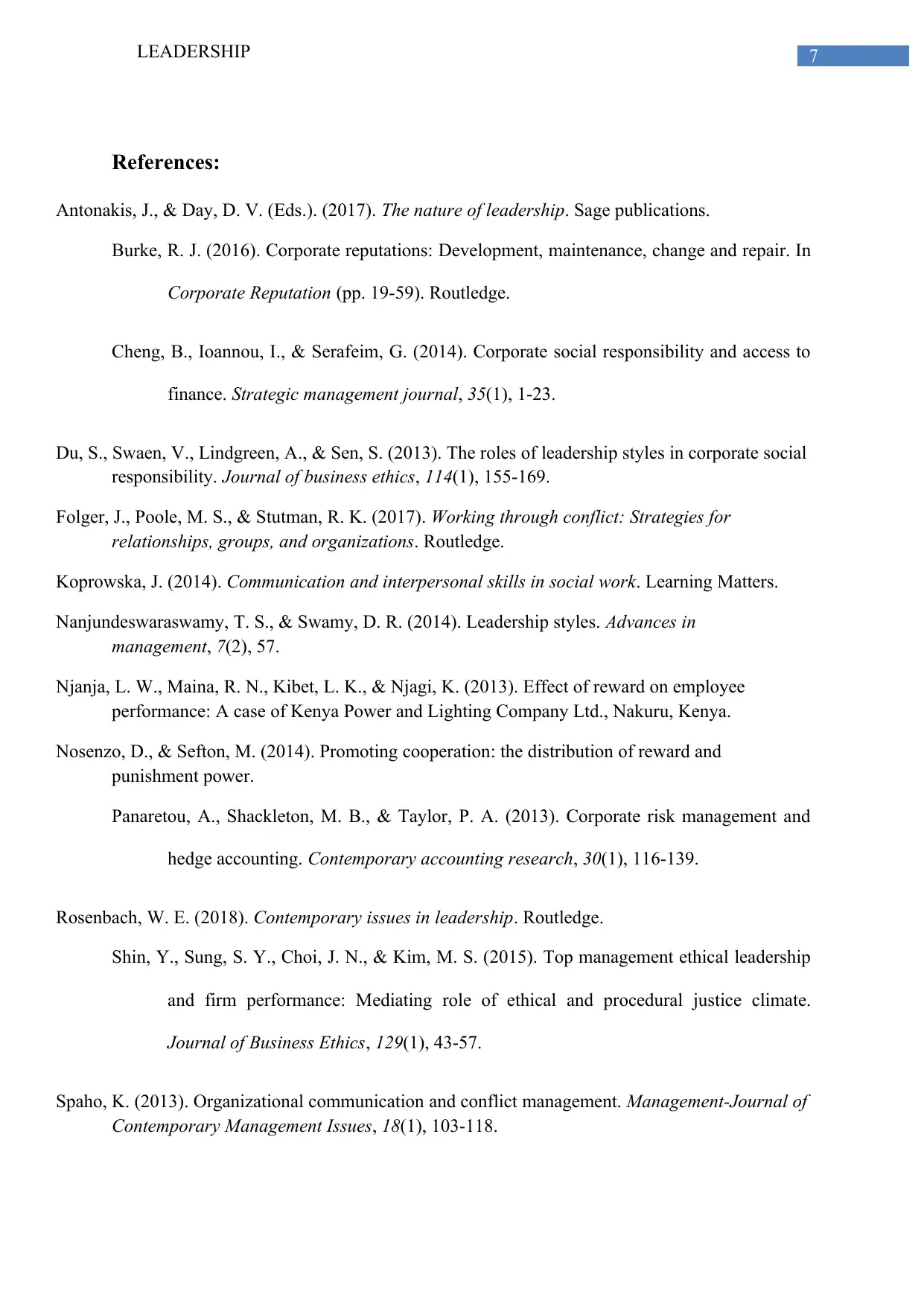
7LEADERSHIP
References:
Antonakis, J., & Day, D. V. (Eds.). (2017). The nature of leadership. Sage publications.
Burke, R. J. (2016). Corporate reputations: Development, maintenance, change and repair. In
Corporate Reputation (pp. 19-59). Routledge.
Cheng, B., Ioannou, I., & Serafeim, G. (2014). Corporate social responsibility and access to
finance. Strategic management journal, 35(1), 1-23.
Du, S., Swaen, V., Lindgreen, A., & Sen, S. (2013). The roles of leadership styles in corporate social
responsibility. Journal of business ethics, 114(1), 155-169.
Folger, J., Poole, M. S., & Stutman, R. K. (2017). Working through conflict: Strategies for
relationships, groups, and organizations. Routledge.
Koprowska, J. (2014). Communication and interpersonal skills in social work. Learning Matters.
Nanjundeswaraswamy, T. S., & Swamy, D. R. (2014). Leadership styles. Advances in
management, 7(2), 57.
Njanja, L. W., Maina, R. N., Kibet, L. K., & Njagi, K. (2013). Effect of reward on employee
performance: A case of Kenya Power and Lighting Company Ltd., Nakuru, Kenya.
Nosenzo, D., & Sefton, M. (2014). Promoting cooperation: the distribution of reward and
punishment power.
Panaretou, A., Shackleton, M. B., & Taylor, P. A. (2013). Corporate risk management and
hedge accounting. Contemporary accounting research, 30(1), 116-139.
Rosenbach, W. E. (2018). Contemporary issues in leadership. Routledge.
Shin, Y., Sung, S. Y., Choi, J. N., & Kim, M. S. (2015). Top management ethical leadership
and firm performance: Mediating role of ethical and procedural justice climate.
Journal of Business Ethics, 129(1), 43-57.
Spaho, K. (2013). Organizational communication and conflict management. Management-Journal of
Contemporary Management Issues, 18(1), 103-118.
References:
Antonakis, J., & Day, D. V. (Eds.). (2017). The nature of leadership. Sage publications.
Burke, R. J. (2016). Corporate reputations: Development, maintenance, change and repair. In
Corporate Reputation (pp. 19-59). Routledge.
Cheng, B., Ioannou, I., & Serafeim, G. (2014). Corporate social responsibility and access to
finance. Strategic management journal, 35(1), 1-23.
Du, S., Swaen, V., Lindgreen, A., & Sen, S. (2013). The roles of leadership styles in corporate social
responsibility. Journal of business ethics, 114(1), 155-169.
Folger, J., Poole, M. S., & Stutman, R. K. (2017). Working through conflict: Strategies for
relationships, groups, and organizations. Routledge.
Koprowska, J. (2014). Communication and interpersonal skills in social work. Learning Matters.
Nanjundeswaraswamy, T. S., & Swamy, D. R. (2014). Leadership styles. Advances in
management, 7(2), 57.
Njanja, L. W., Maina, R. N., Kibet, L. K., & Njagi, K. (2013). Effect of reward on employee
performance: A case of Kenya Power and Lighting Company Ltd., Nakuru, Kenya.
Nosenzo, D., & Sefton, M. (2014). Promoting cooperation: the distribution of reward and
punishment power.
Panaretou, A., Shackleton, M. B., & Taylor, P. A. (2013). Corporate risk management and
hedge accounting. Contemporary accounting research, 30(1), 116-139.
Rosenbach, W. E. (2018). Contemporary issues in leadership. Routledge.
Shin, Y., Sung, S. Y., Choi, J. N., & Kim, M. S. (2015). Top management ethical leadership
and firm performance: Mediating role of ethical and procedural justice climate.
Journal of Business Ethics, 129(1), 43-57.
Spaho, K. (2013). Organizational communication and conflict management. Management-Journal of
Contemporary Management Issues, 18(1), 103-118.
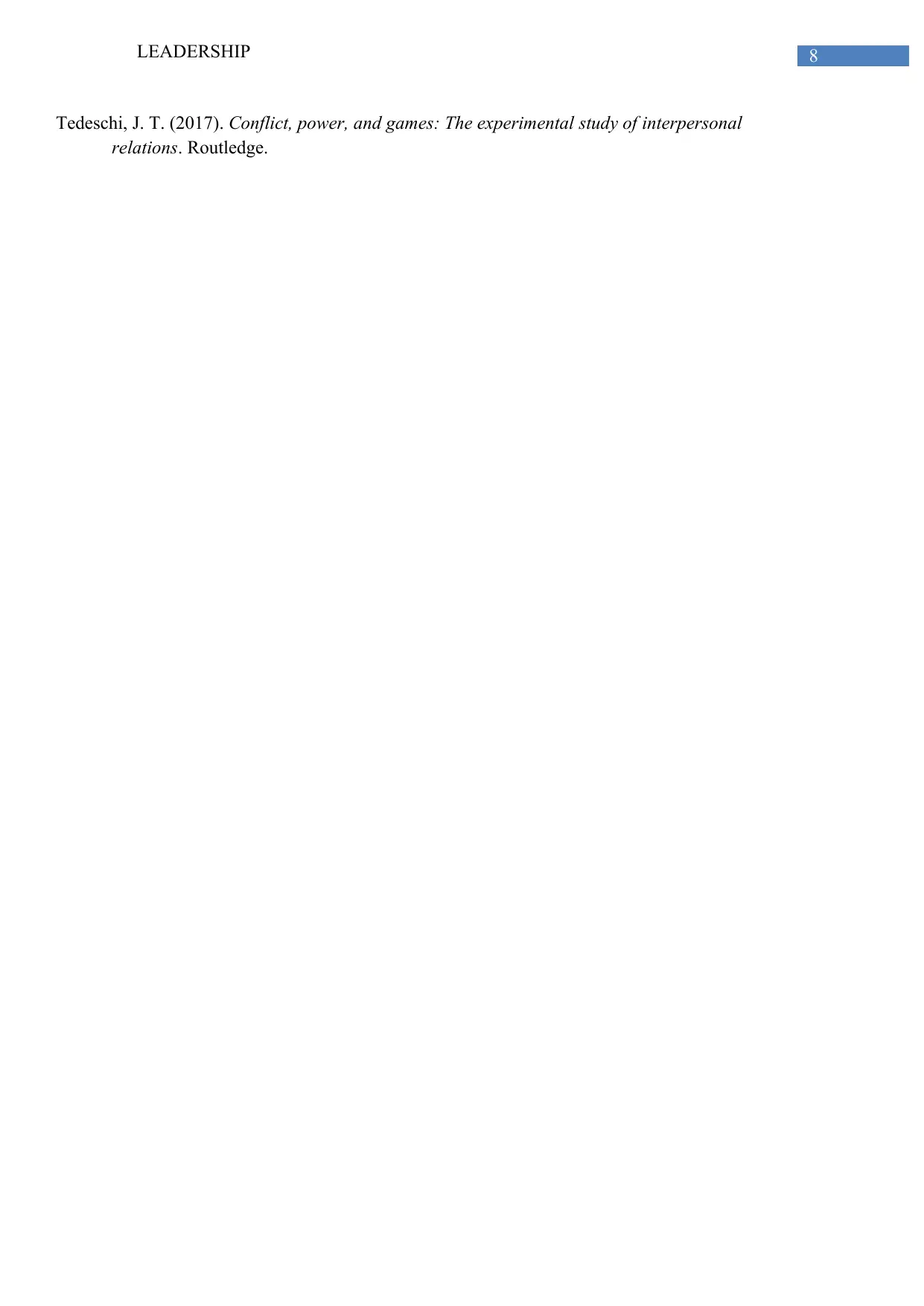
8LEADERSHIP
Tedeschi, J. T. (2017). Conflict, power, and games: The experimental study of interpersonal
relations. Routledge.
Tedeschi, J. T. (2017). Conflict, power, and games: The experimental study of interpersonal
relations. Routledge.
⊘ This is a preview!⊘
Do you want full access?
Subscribe today to unlock all pages.

Trusted by 1+ million students worldwide
1 out of 9
Related Documents
Your All-in-One AI-Powered Toolkit for Academic Success.
+13062052269
info@desklib.com
Available 24*7 on WhatsApp / Email
![[object Object]](/_next/static/media/star-bottom.7253800d.svg)
Unlock your academic potential
Copyright © 2020–2025 A2Z Services. All Rights Reserved. Developed and managed by ZUCOL.





